Celtic Interconnector
The Celtic Interconnector cable will enable the exchange of 700 MW of electricity between Ireland and France. Moving this electricity across a distance of 575km, with 500km of the cable running under the sea, this interconnector will have the capacity to supply electricity to 450,000 homes. The project is a key step on Ireland’s energy journey to a low carbon energy future. It will make an important contribution to shoring up Ireland's security of electricity supply by providing a direct link to continental Europe.

Project Overview
The Celtic Interconnector project will create an electrical interconnection between Ireland and France to allow the exchange of electricity between the two countries.
It is being developed with EirGrid and our French equivalent Réseau de Transport d’Electricité (RTE) and will be the first interconnector between Ireland and continental Europe.
The Celtic Interconnector will travel from east Cork to the north-west coast of Brittany.
The project is co-funded by EirGrid and RTE. In 2019, it was awarded €530.7 million from the European Commission’s Connecting Europe Facility (CEF).
Some EU funding was also received as a Project of Common Interest (PCI). A PCI is an infrastructure project that links the energy systems of EU countries. It gives the project enhanced status, as well as more efficient access to planning permission and permits.
You can keep up with the latest developments in the Updates section below, and you can also read a round-up of major developments in our quarterly newsletters, which will bring you up to date on the works in Ireland and in France, community benefit and other topics related to the delivery of this strategic energy project.
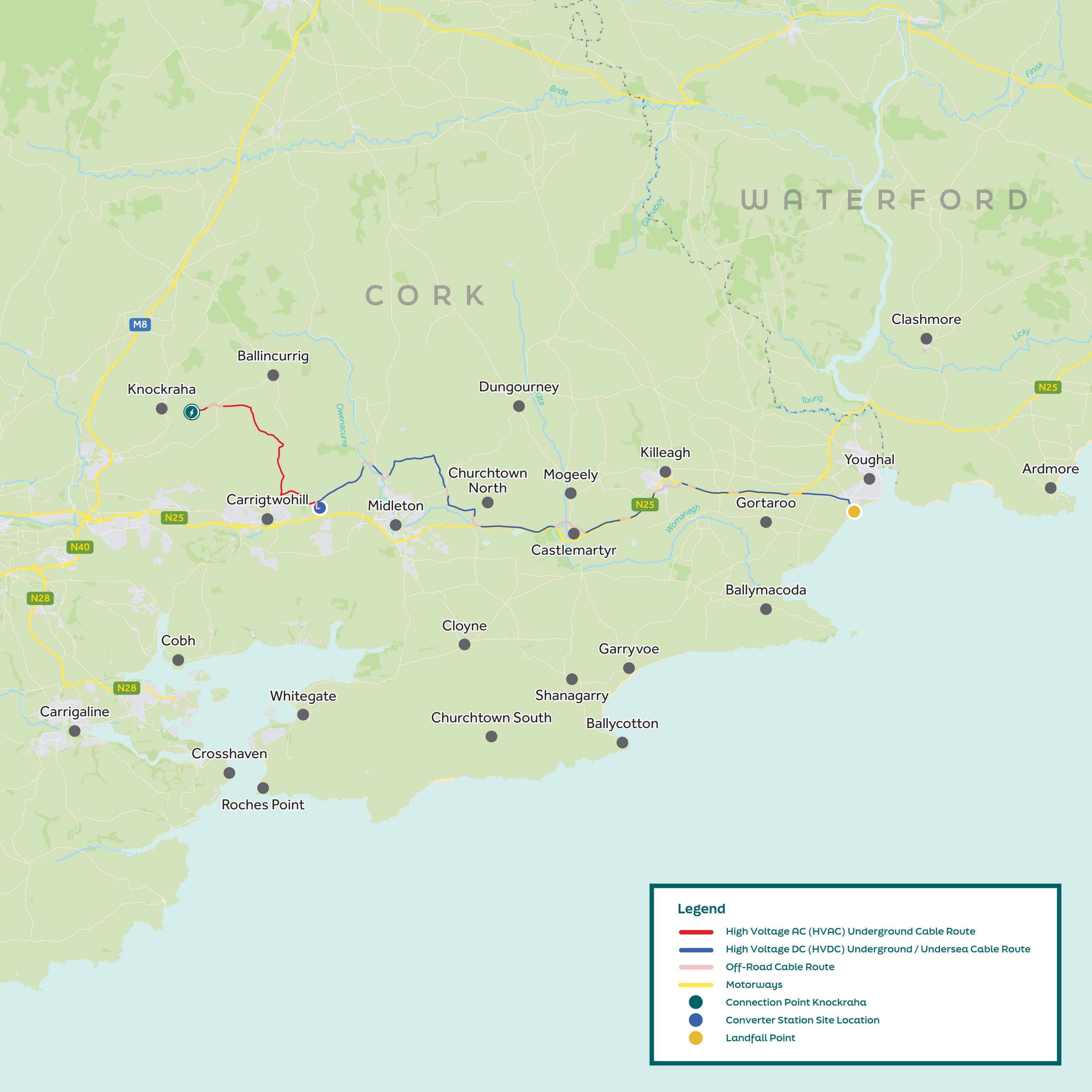
Benefits of the Project
When built, the Celtic Interconnector will bring many benefits for Ireland, France, and the EU. It will:
- Allow 700 MW megawatts of electricity to move between the countries (equal to power for around 450,000 homes)
- Make Ireland's electricity supply more secure, directly connecting the Irish grid to another EU member state
- Help achieve our climate objectives and put downward pressure on the cost of electricity
The Celtic Interconnector is part of developing an integrated energy system for Europe. A fully integrated energy market will help the EU to:
- Achieve affordable, secure, and sustainable energy for all citizens
- Promote renewable energy for a low-carbon energy future
- Improve electricity exports to markets and consumers, both inside and outside Europe
The Technology
High Voltage Alternating Current Electricity Cable (HVAC) and High Voltage Direct Current Electricity Cable (HVDC) Land and Submarine Circuits
Ireland and France both use HVAC technology to move electricity around their networks and supply consumers.
However, different technology is needed to transfer electricity at long distances: HVDC. This is the industry standard for long distances.
For this project the following circuits will be used to transport electricity:
- A HVAC circuit from the network connection point at Knockraha Substation to the converter station at Ballyadam, near Carrigtwohill
- A HVDC land circuit from the converter station to the landfall at Claycastle Beach in Youghal
- A HVDC submarine circuit under the sea
The HVDC interconnector between Ireland and France will be about 575km long. This includes the subsea and the onshore cable to the converter station. The cables for the HVAC and HVDC are all underground.
Converter Stations
Converter stations will be built in each country to change the electricity from HVDC to HVAC, and the other way around. After it is converted from HVDC to HVAC technology at the converter station, the electricity will be transferred to the existing substations in each country.
Network Connection
Two existing substations were identified as the best locations to connect to the transmission system in each country. The existing stations are located at:
- Knockraha, Cork in Ireland
- La Martyre in France
You can see the main elements of the proposed infrastructure in Ireland in the graphic below.
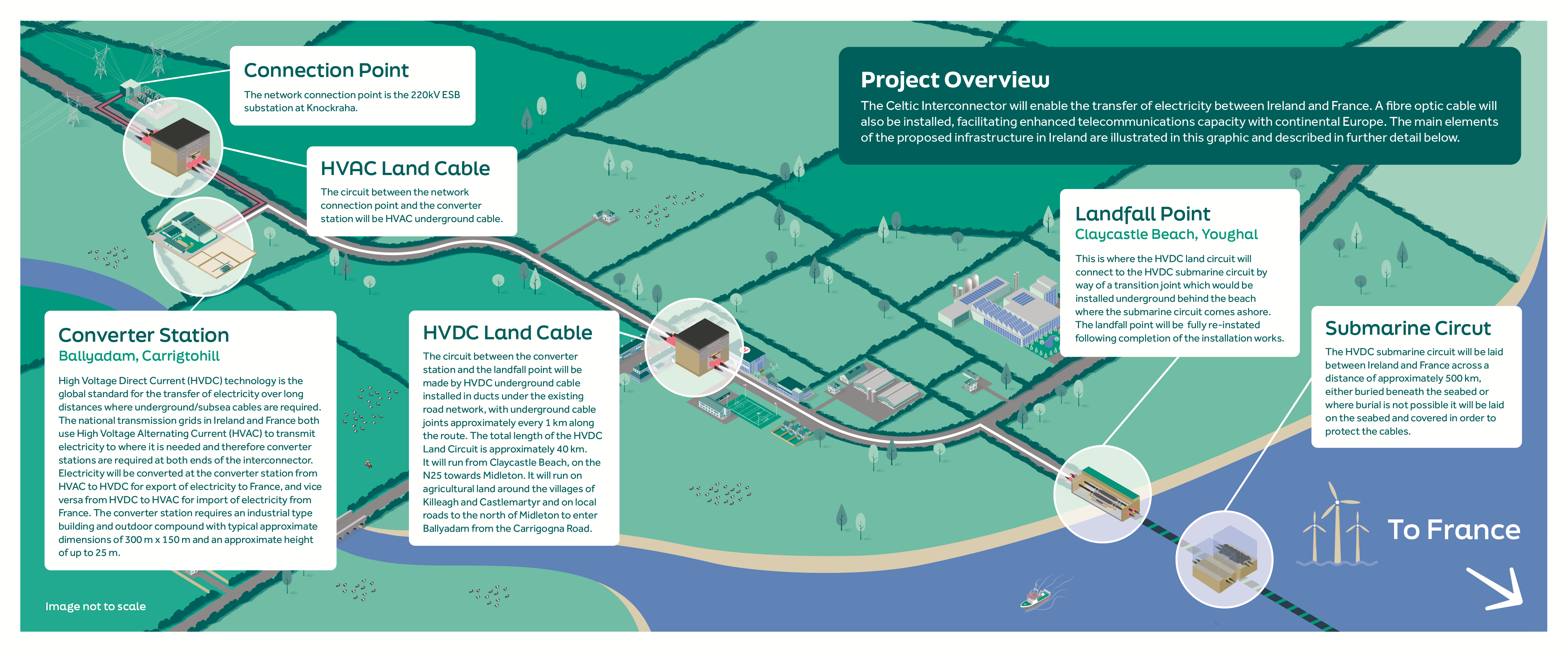
Where Are We Now?
We are now at Step 6 – the construction, energisation and benefit sharing phase. We estimate construction will be completed in 2026.
We use a six-step approach to developing projects to improve the grid. You'll see these steps mentioned across our project plans. As part of our six-step approach to developing projects, we ask for regular feedback from the public and other stakeholders. The steps indicate how far along we are in a project. Our 'Have Your Say' document explains these steps in more detail.
A Project of Common Interest
The European Union has partly funded the Celtic Interconnector and designated it as a Project of Common Interest (PCI).
A PCI is an infrastructure project that links the energy systems of EU countries.
It gives the project a higher status, allows more efficient access to planning permission and permitting processes.
As a PCI the Celtic Interconnector also has access to financial support from the Connecting Europe Facility (CEF) – a fund to develop Europe’s energy, transport and digital networks.
Community Forum
The Celtic Interconnector Community Forum brings together people and organisations from across the project area so that stakeholder and community views can be discussed, understood and properly considered prior to and during project delivery. This community forum will create the opportunity for dialogue between stakeholders with diverse and direct interest in the project and the EirGrid project team.
Irish Rural Link has been appointed as the community forum's independent facilitator.
Irish Rural Link (IRL), formed in 1991, is a national network of organisations and individuals campaigning for sustainable rural development in Ireland and Europe. IRL, a non-profit organisation, now directly represents over 600 community groups with a combined membership of 25,000. The organisation has a long, successful track record in designing and implementing community relations plans for development companies, community organisations, semi-state agencies and Government.
The purpose of the forum is to ensure that stakeholder and community views are understood and properly considered prior to and during project delivery. The group will provide a forum for dialogue between stakeholders with interests in the project and the project team. Community Forum members will also be invited to input on the design and implementation of the Community Benefit Fund.
Communications
To help forum members share information with their community please see the resources below:
Social media notice
This notice provides the Celtic Free Text registration information and is designed for use on WhatsApp, Facebook and other social media platforms. This can be downloaded, saved to and sent from your smart phone.
To save it to your phone, simply press and hold the image until a menu pops up, and choose the appropriate action. To save it on a computer, right-click the picture and choose "Save image as".
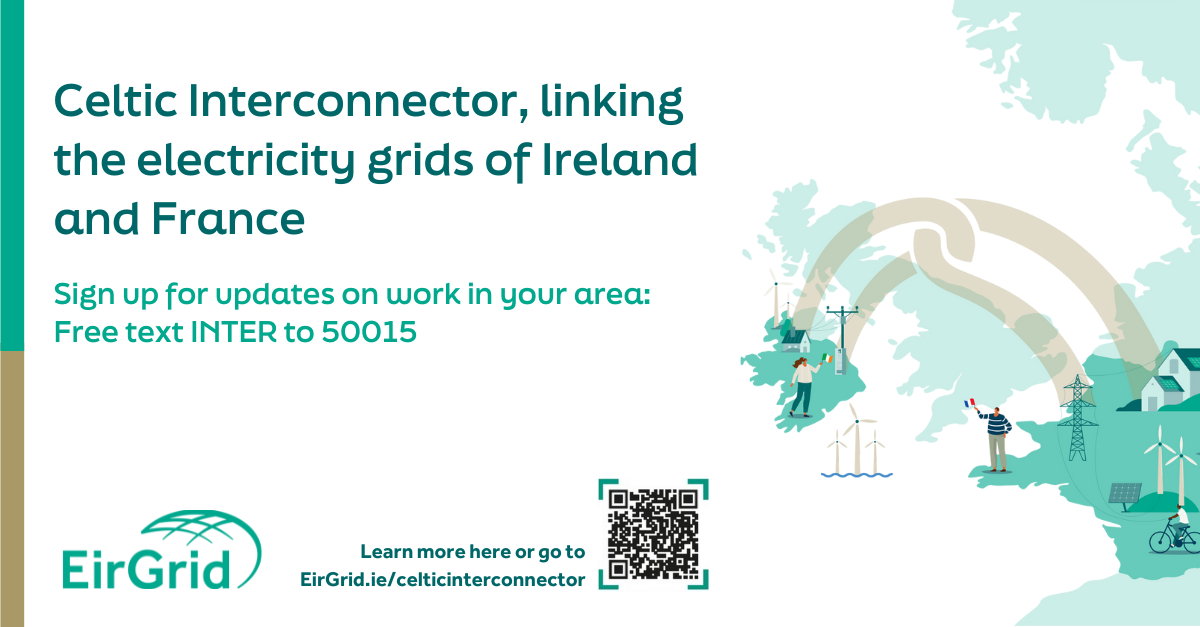
Poster
This is a downloadable and printable poster encouraging people to register for updates on the Celtic Interconnector.
Celtic Interconnector Community Benefit Fund
The €2.4 million Celtic Interconnector Community Benefit Fund has been established by EirGrid. Communities play an important role in facilitating grid infrastructure, as we work towards achieving our climate ambitions.
The fund recognises the importance of local communities who support this work. It also recognises the temporary disruption which may be caused within proximity of the cable line during the construction phase of the project.
The overall aim is to increase public and environmental wellbeing in the community and to leave a positive legacy in the communities hosting EirGrid infrastructure.
Project Updates
April 2024
Cable Construction Information Events
Works have commenced in the east Cork area, and road closures for the work may impact you.
As part of ongoing information and engagement activities, two cable construction information sessions will be held at The Midleton Park Hotel, Midleton, to keep people up to date on the works.
They are taking place on Tuesday 9 April, from 4pm to 6.30pm, and Wednesday 10 April, from 6pm to 8pm.
You can read more about the events here.
March 2024
An archaeological investigation to explore the extent of remains of a petrified forest under Claycastle Beach in Youghal will commence on Monday, 11 March.
The minor investigation will consist of a test pit on the beach and will be overseen by archaeologists from the Underwater Archaeology Unit and the National Monuments Service.
It is expected the investigation will last four days, concluding on Thursday, 14 March.
February 2024
Our second Celtic Interconnector Community Newsletter is now available.
The newsletter will bring you up to date on the works in Ireland and in France, current works on the project, community benefit and other topics related to the delivery of this strategic energy project.
Now that works have commenced, we look forward to continuing to keep you up to date with this quarterly newsletter.
January 2024
Section 146B request
A Section 146B request for alteration was recently made to An Bord Pleanála by EirGrid. This request is for the creation of a permanent vehicular access to the Cable Sealing End (CSE) compound which is to be situated immediately to the east of the existing Knockraha 220kV substation.
The details of the request and public consultation can be read at www.eirgridcelticinterconnector.ie on the Section 146B Modification page.
The public consultation period will open on Thursday 1 February and run for four weeks, closing on 28 February 2024.
Road Closure Licence Application
As part of the roadworks programme, Sorensen has now applied to Cork County Council for a temporary full road closure licence for Road Number L-7634 to Hagerty’s Cross/Upper Garranes.
This is referred to as Section C in the Road Closure section map.
The application is for a temporary full road closure licence from 6am on Friday 1 March to 6pm Friday 31 May.
For more information please see the Road Closure Updates section.
Work recommences
Following the Christmas break cable road works recommenced in Section B – Ballinakilla L-7631 and Section E - Woodstock Hill – L-3606 in January 2024.
For additional information on cable sections and associated works please see Road Closure Updates.
Pre-work activities for work at Ballyvergan Marsh, Youghal are taking place from Monday 22 January for approximately four weeks.
These works can include trial holes, slit trenches and surveys as well as site clearance works, in preparation for the proposed trenching and ducting for the cable installation.
To facilitate the safe works, Sorensen will have traffic management in place on the R633 and Front Strand Road as outlined below from Monday 22 January for about four weeks.
Temporary Entrance to the Marsh is outlined below in BLUE.
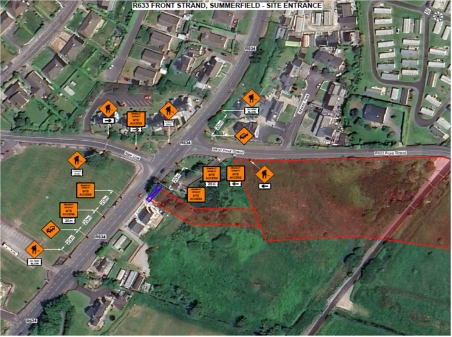
Access will be maintained in the area at all times and Sorensen will make every effort to minimise any disruption to residents, businesses, and the public along the route during the cable works.
To register for FREE text updates on road closures please text INTER to 50015
Road Closure Updates
Installation of Underground Cables
Your privacy settings
In order to allow the use of multimedia content on this website you must accept the use of miscellaneous cookies.
Installation of underground cable
The cable installation animation above demonstrates the different stages of work required when installing underground cable.
Stage 1 – Preparation of the cable route
This starts with the excavation of the cable trench in the road, the installation of cable ducts and the installation of passing bays in preparation for future construction works.
To ensure the health and safety of workers and facilitate progress, this work requires temporary road closures on non-national roads.
Once the preparatory cable route work is completed the final step is to install joint bays in the road.
At this final step, the use of the pre-installed passing bays will eliminate the need for road closures.
Once completed the road is reinstated.
Stage 2 - Cable installation and associated works
At this stage, the cable is pulled through the pre-laid ducts. This work happens in the area of the joint bays.
During this time traffic can again use the passing bays, eliminating the need for road closures.
Stage 3 - Jointing of cable sections
This involves detailed joining work to be carried out inside the joint bays. Again, the installed passing bays eliminate the need for road closures.
The final road surface reinstatement and removal of passing bays is then completed.
Temporary road closures will again be required at this final step on non-national roads, although the closures required will be limited with only areas around the joint and passing bays requiring reinstatement.
Celtic Interconnector
On-land cable works (trenching and ducting) for the Celtic Interconnector project commenced in November 2023.
The work began at Knockraha substation and will progress towards Carrigtwohill; continuing easterly over the course of the project. The cable route from Knockraha to Churchtown, where the cable enters onto the N25, has been divided into sections. Please see section map below.
Each section will require a Temporary Road Closure Licence to be applied for and awarded prior to work commencing. End-to-end sections will not be completed at the same time to facilitate better traffic movement.
Local and emergency access to affected roads will continue at all times and every effort will be made to minimise disruption to residents, businesses, and the public along the route during the cable works.
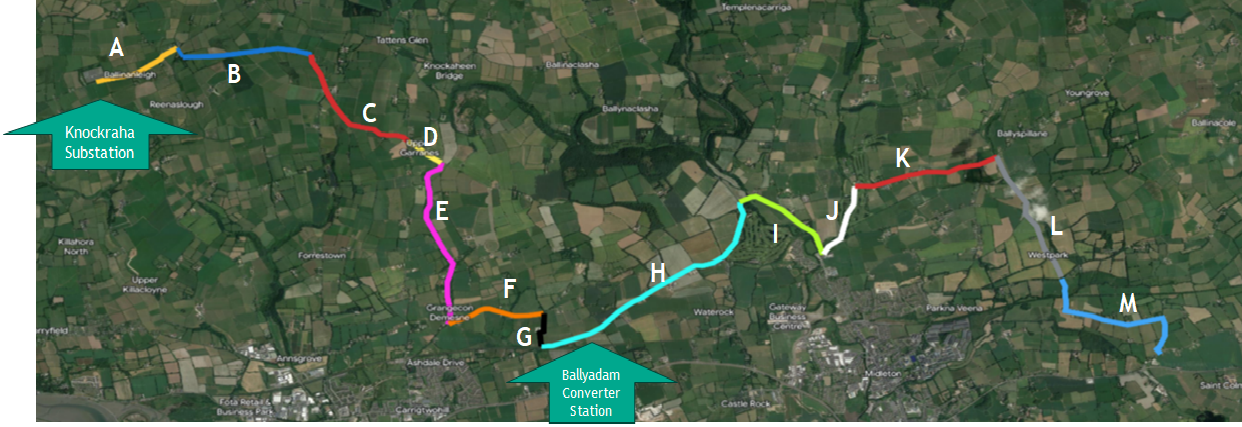
Get in Touch to Learn More
- If you have any queries regarding construction works, please contact Elaine Cronin, Sorensen Liaison Officer at 086 032 6171.
- If you would like to receive email alerts, email celticinterconnector@sorensen.ie
- To receive Text Updates, subscribe to our FREE Text service by texting INTER to 50015.
Newsletters
Project Documents
Below are documents about the Celtic Interconnector. We have organised the documents depending on which stage (step) of the project they refer to in EirGrid’s Six Step Process for developing projects in Ireland.
They are listed in order from most recent to earliest. You can also search for 'Celtic Interconnector' in our Publications section for all related documents.
EirGrid plc’s Strategic Infrastructure Development application to An Bord Pleanála for the Celtic Interconnector Project is available to view on this website
Step 5 Documents
- Comprehensive Decision
- Foreshore Licence - Notice of Determination
- An Bord Pleanála, Board Order – 310798 | An Bord Pleanála (pleanala.ie)
- Webinar Slide Deck Presentation on the Environmental Aspects of Electric and Magnetic Fields from Transmission Lines - September 2021
- Community Update Brochure - July 2021 - Guide to Public Participation in the Strategic Infrastructure Development Planning Application Process
- Cable Route Options Review Report
- Webinar Slide Deck Presentation - April 2021
- Community Forum Information Evening - 21 April 2021
- Celtic Interconnector Webinar - Wednesday 7 April 2021
- Celtic Interconnector Webinar - Thursday 8 April 2021
Step 4 Documents
- Step 4b Consultant's Development Options Report
- Step 4b Brochure (Winter 2020)
- Step 4b - Press release
- Step 4 Overview Presentation
- Cable Route Map
- Video: what does a converter station look like?
- Celtic Interconnector Underground Cable Brochure
- Celtic Interconnector Webinar (August 2020)
- Step 4 Project Update Document (Spring 2020)
- Step 4 Consultation Report
- Preliminary Acoustic Study Report
- Step 4 Brochure (Winter 2019-2020)
- Step 4A Consultant’s Development Options Report
Step 4 Maps
Step 3 Documents
- Preferred Options Report
- Consultation Response Document
- Consultation Report
- Project Update Brochure - Step 3 Consultation (Spring 2019)
- Offshore Constraints Report
- Onshore Constraints Report and Mapping
- Strategic Social Impact Assessment Scoping Report
- Performance Matrix Assessments
- Project Update Brochure (2018)
Step 2 Documents
Step 2 Land Reports
- Land Report 1 - Feasibility Study - Converter Station Site and Route Identification in Ireland and Associated Mapping (All maps associated with this study are available for download via hyperlinks throughout the report)
- Land Report 2
Health
Project of Common Interest Process
- Project of Common Interest Information Brochure
- Letter from Competent Authority to EirGrid Approving Concept for Public Participation (2020)
- EirGrid Concept for Public Participation (2020)
- Letter from Competent Authority to EirGrid Acknowledge Project of Common Interest Notificatio (2019)
- Pre-Application Notification from EirGrid to Competent Authority (2018)
Community Forum Minutes of Meetings
- Community Forum Meeting 22 June 2021 - Minutes
- Community Forum Meeting 14 September 2021 - Minutes
- Community Forum Meeting 8 November 2021 - Minutes
- Community Forum Meeting 8 March 2022 - Minutes
- Community Forum Meeting 14 July 2022 - Minutes
- Community Forum Meeting 29 September 2022 - Minutes
- Community Forum Meeting 6 December 2022 - Minutes
- Community Forum Meeting 5 April 2023
- Community Forum Meeting 4 July 2023 - Minutes
- Community Forum Meeting 17 October 2023 - Minutes to follow
Community Forum Presentations
- Community Forum Meeting 22 June 2021
- Community Forum Meeting 14 September 2021
- Community Forum Meeting 8 November 2021
- Community Forum Meeting 8 March 2022
- Community Forum Meeting 14 July 2022
- Community Forum Meeting 29 September 2022
- Community Forum Meeting 6 December 2022
- Community Forum Meeting 5 April 2023
- Community Forum Meeting 4 July 2023
- Community Forum Meeting 17 October 2023
Project Contacts
EirGrid Customer Relations
Phone: +353 1 237 0472 Email: celticinterconnector@eirgrid.com Post: The Celtic Interconnector Project Manager EirGrid plc., The Oval, 160 Shelbourne Road, Ballsbridge, Dublin 4, Ireland
Community Liaison Officers
Michelle Walsh, Celtic Interconnector Community Liaison Officer Phone: +353 85 870 4999 Eoghan O’Sullivan, Community Liaison Officer Phone: +353 87 247 7732